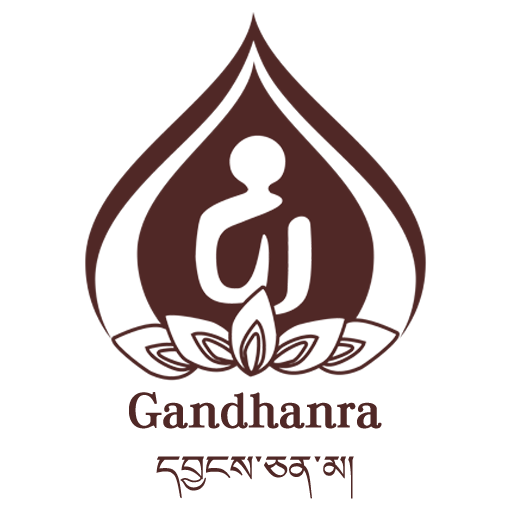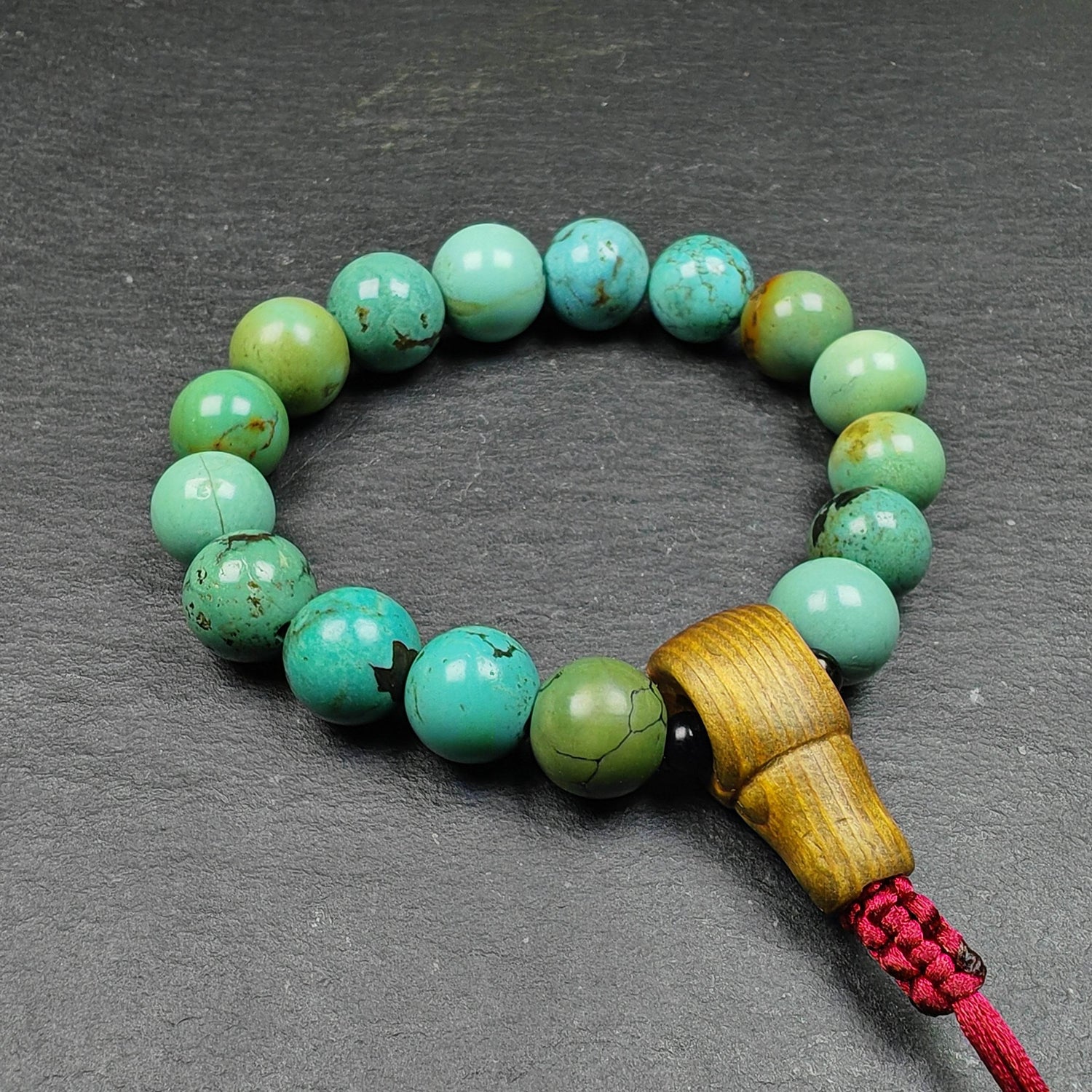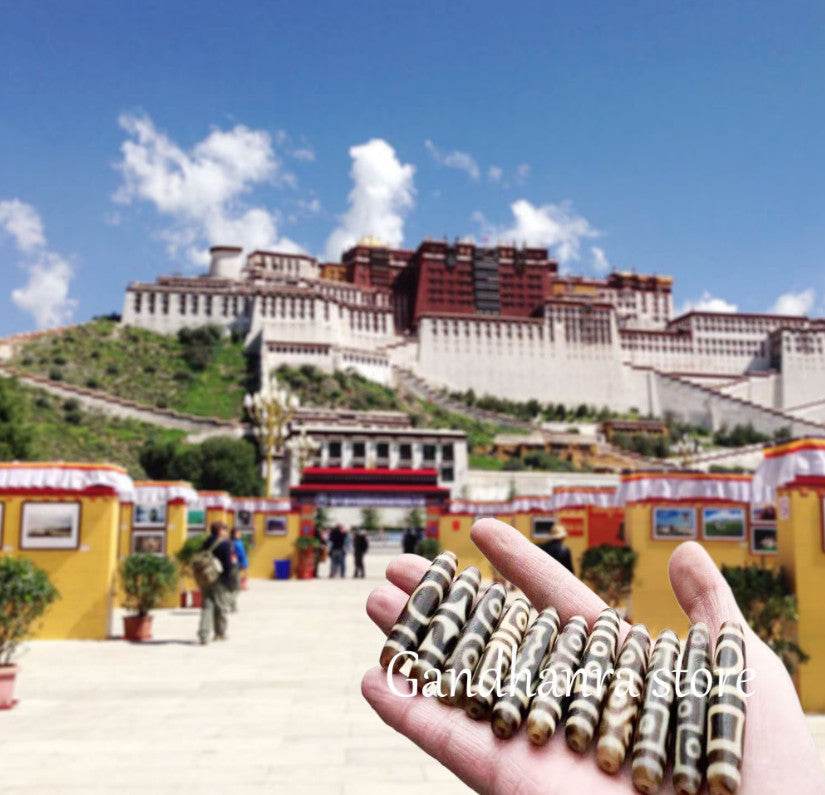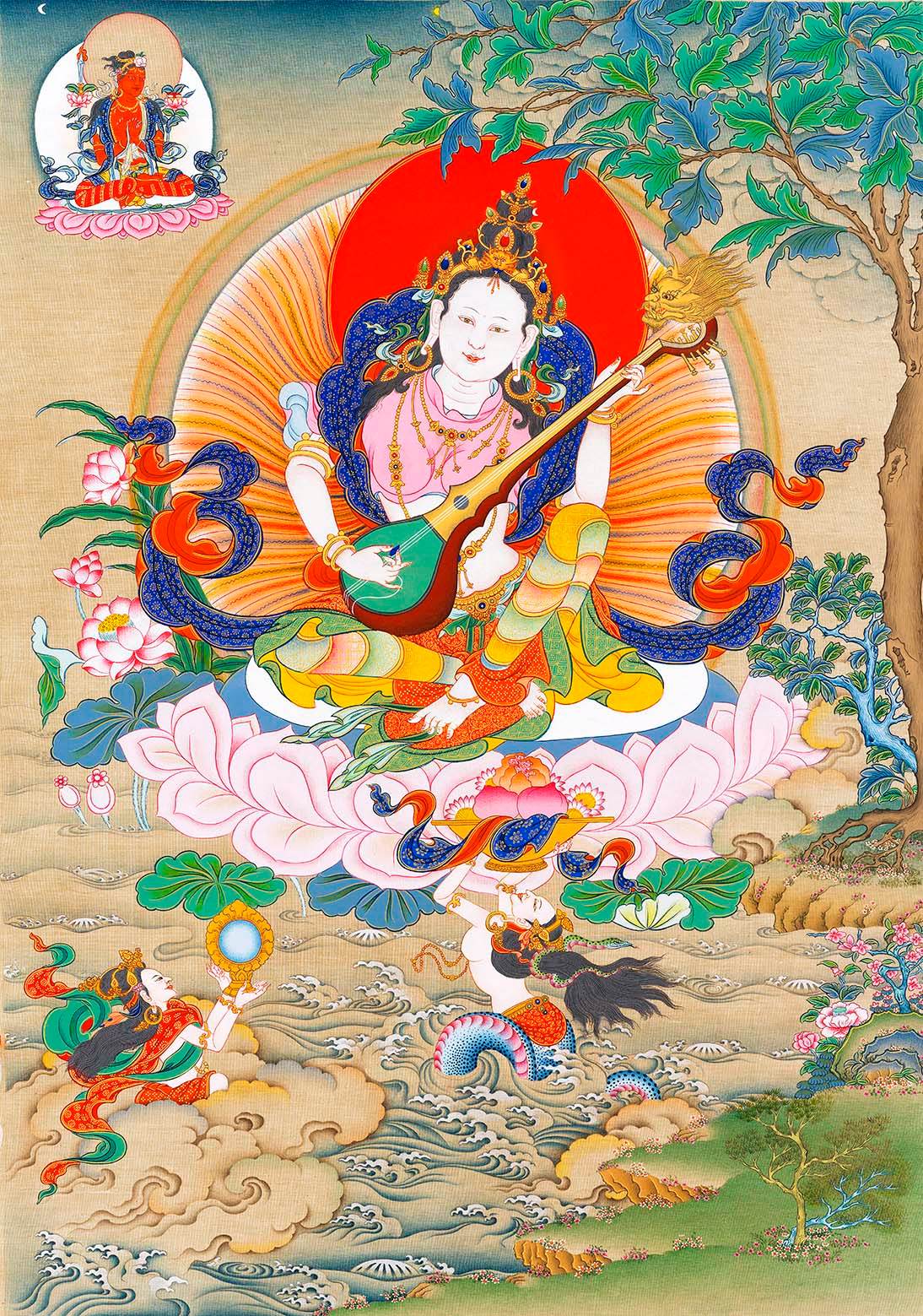
The Connection Between Tibet and Mount Wutai (Part 2)

Manjushri, Qianlong 26th Year (1761)
By Ding Guanpeng
Collection of the National Palace Museum, Taipei, China

"Manjushri Thangka"
Collection of Rossi & Rossi Gallery

The illustration of Mount Wutai from "The New Gazetteer of Mount Qingliang"

Mount Wutai
Photographed by Karl Johaentges
Image source: lookphotos
The History of Mount Wutai Written in Tibetan
In our previous issue, we outlined the historical transmission of Mount Wutai into Tibetan culture through key events. In this installment, we will examine the textual and theoretical dimensions of how Tibetan scholars introduced and interpreted this sacred site.
The most direct and representative texts reflecting this process are the gazetteers (gnas yig). Undoubtedly, the revision of Tibetan-language Mount Wutai gazetteers marks the maturation of Mount Wutai’s conceptual framework within Tibetan Buddhism. Among these, the most renowned is The Chronicle of the Sacred Mountain of Cool and Clear Light: A Sun of Wonders That Makes the Lotus of Faith Bloom (ཞིང་མཆོག་རི་བོ་དྭངས་བསིལ་གྱི་གནས་ཡིག་དད་པའི་པདྨོ་རྒྱས་བྱེད་ངོ་མཚར་ཉི་མའི་སྣང་བ) by Changkya Rölpé Dorjé (ལྕང་སྐྱ་རོལ་པའི་རྡོ་རྗེ།, 1717–1786).

Changkya Rolpai Dorje
Private Collection
On the Compilation of This Chronicle
As explained by Thuken (ཐུའུ་བཀྭན་བློ་བཟང་ཆོས་ཀྱི་ཉི་མ།, 1737–1801), a disciple of Changkya Rölpé Dorjé:
"During our visit to Mount Wutai, we came across an old chronicle composed by Dze’a Pa Pelden Drakpa. However, its content was far too brief. Another version, translated from Chinese, was riddled with errors and thus obscure in meaning. For this reason, we requested [the Later Changkya Master] to compile a more detailed chronicle. He consented and orally dictated the majority of the text, yet it remained unfinished—as if there were some profound karmic consideration behind this."
Changkya arrived in Beijing at the age of seven, where he gained the emperor’s favor and studied alongside the future Qianlong Emperor while the latter was still a prince. Fluent in Tibetan, Chinese, Manchu, and Mongolian, he later became the Imperial Preceptor (State Teacher) of the Qing Dynasty, overseeing major cultural projects such as the Mongolian translation of the Tengyur (Danjur) and the Manchu translation of the Kangyur (Ganjur).
From 1750 until his passing, he spent every summer in retreat at Mount Wutai. His Biography records numerous wondrous deeds performed there.

Changkya Rolpai Dorje
Philadelphia Museum of Art Collection
The works attributed to Master Changkya were not actually written by him.
It is noteworthy that this work has long been attributed to Master Changkya and was believed to be "an original composition with its own distinct title, not merely known as a translation." However, the extant Tibetan Guide to Mount Wutai bearing the name "Changkya Rölpé Dorjé" was neither authored nor even translated by him.
In 1767, Changkya began drafting the text but abandoned it after completing roughly the first chapter and a half. Over time, his disciples revised and expanded the manuscript until 1831, when Janglung Pandita Ngawang Lobzang Tenpai Gyaltsen (1770–1845), a descendant of Genghis Khan, finally edited and published it in its complete form.
The Biography of Janglung Pandita records this textual evolution as follows:
"Changkya Rölpé Dorjé rendered [the original Tibetan version] into clear and accessible language, yet progress halted after the third volume. Although a partial translation by a certain Alashan master was later obtained, it remained riddled with omissions and errors. Thus, [Janglung Pandita] painstakingly collated and revised the text, supplementing it with mountain eulogies composed by the Yongzheng Emperor and other nobles, along with five concluding hymns—including a praise to the Vajradhara Changkya Rölpé Dorjé—before publishing it that same year. To ensure wide dissemination, the woodblocks were entrusted to the Songzhu Temple."

Printed in 1831, the Songzhu Temple edition
What was the source text for this famous Tibetan mountain guide?
It was based on the Chinese work New Gazetteer of Mount Qingliang (Qingliangshan Xinzhi). This gazetteer was originally compiled by Lozang Drakpa, a monk overseeing religious affairs at Mount Wutai during that period.
When the Kangxi Emperor reviewed the text, he was thoroughly pleased and personally composed its preface, stating:
"This compilation strikes a perfect balance between detail and conciseness—neither overly elaborate nor lacking. The sacred landscape of [Mount] Qingliang can be grasped in its essence simply by perusing its pages. Thus, I have written this preface for it."
The emperor’s endorsement effectively transformed this private work into an official gazetteer. While other Chinese guides to Mount Wutai existed at the time, it is understandable why Changkya’s disciples chose this particular text as their foundational source.

The Kangxi Emperor
The Reflections of Tibetan Scholar
Though Changkya's Mount Wutai Gazetteer was in fact completed by his disciples as a translation, it contains many fascinating and significant details worthy of deeper consideration—most notably its overall structure. The original Chinese text comprised ten chapters, yet the so-called Tibetan "translation" condensed these into only five. These five chapters did not simply omit half of the Chinese content but rather completely reorganized it into a new framework. This approach reveals precisely what these two articles aim to highlight: Tibetan scholars were consciously constructing a distinctly Tibetan system of Mount Wutai belief.
This intention manifests elsewhere as well. For instance, the Tibetan version incorporated numerous accounts of Changkya and other Tibetan intellectuals at Mount Wutai while omitting stories of Han Chinese patrons or eminent monks found in the original. There is reason to believe this was not merely a localization strategy in translation, for as discussed in the previous article, such efforts had a long history. Moreover, based on the first two chapters written by Changkya himself, it appears the master initially intended to compose an entirely new Tibetan gazetteer of Mount Wutai rather than a translation. A similar inclination can be detected in one of his Mount Wutai eulogies—a point that seems to have gone unnoticed in academia thus far.

Content of the New Gazetteer of Mount Qingliang
Lost works
The passage by Thuken quoted at the beginning of this article is of great significance, for beyond detailing the compilation process of this mountain gazetteer, it provides two crucial clues:
Prior to Changkya, there existed other Tibetan-language gazetteers of Mount Wutai;
Prior to Changkya, there was an inferior Tibetan translation (of a Chinese gazetteer).
Based on extant materials, Tibetan-language gazetteers of Mount Wutai did indeed predate Changkya's work. The most notable among these was likely the one composed by Gönpo Kyap (Gung thang dgon po skyabs, see our previous article for details about this figure). In another of his own writings, Gönpo Kyap explicitly mentioned having authored such a Tibetan gazetteer of Mount Wutai, though this work is now lost (a translation appears to survive in Mongolian textual sources).
Although Gönpo Kyap's gazetteer did not survive, he was contemporaneous with Changkya, who may have encountered this work. As noted earlier, the first two chapters written by Changkya were not translated from Chinese, and their phrasing bears strong traces of influence from Gönpo Kyap's composition. Consequently, some scholars have speculated that the so-called "Changkya's gazetteer" might in fact be the now-lost work of Gönpo Kyap.

"The Canon of Iconometry" translated from Tibetan by Gönpo Kyap

Beijing Edition of The History of Buddhism in China
(from the study Gönpo Kyap and the Textual Lineage of The Chronicle of Buddhism in the Central Plains)"
After Changkya Rölpé Dorjé until the end of the Qing dynasty, numerous Tibetan-language gazetteers of Mount Wutai emerged, though most have since been lost. Among those from this period that remain accessible today—having been republished in modern times—is The Clear Mirror: A Gazetteer of Mount Wutai (Ri bo rtse lnga’i dkar chag rab gsal me long), composed in the early 19th century by the Mongol translator Jñāna Śrīmāna (ཛྙཱ་ན་ཤྲཱི་མཱ་ན).
To date, this work has received little scholarly attention, yet it represents a definitive synthesis ("great compendium") of Tibetan gazetteers of Mount Wutai. Like his predecessors, the author was fluent in multiple languages and drew from a rich array of sources, incorporating materials from Chinese, Tibetan, and other textual traditions. Beyond the conventional narratives of Mount Wutai, he supplemented his account with contemporaneous historical events. Nevertheless, it is worth reemphasizing that this work inherits the intellectual spirit of earlier scholars like Changkya, as the author examines this Shanxi mountain through the lens of a Tibetan cultural scholar.

Cover of Jñāna Śrīmāna's Gazetteer of Mount Wutai
In summary, even when examining solely the revisions of Tibetan-language Mount Wutai gazetteers, Tibetan cultural scholars achieved remarkable success. They progressed from initial introductions to original compositions, systematically constructing a distinct Tibetan Buddhist perception of Mount Wutai.
So what exactly constitutes this "Tibetan perspective"? While a comprehensive discussion exceeds the scope of this article, in essence, it represents differences in the Mount Wutai belief system as shaped by the respective religious traditions of Tibet and China. This Tibetan endeavor traces back to the initiatives of the Great Fifth Dalai Lama (see our previous installment). Professor Tsering has conducted specialized research on this subject, which interested readers may consult for further reference.

Phagpa
Rubin Museum of Art Collection
Tibetan Poems on Mount Wutai
Indeed, beyond the mountain gazetteers, the Tibetan conceptualization of Mount Wutai manifested in other dimensions—most notably in theoretical works, particularly the eulogies composed by Tibetan scholars. These texts hold equal significance. As noted by Western scholar Kurtis R. Schaeffer in his pioneering thematic study:
"Tibetan poetry about Mount Wutai revolves predominantly around visual imagery, with its expansive thematic focus often tied to light. Yet we might pause to consider the poets’ remarkable endeavor: to evoke vision through sound, to appeal to the visual senses via written or oral language, and to transform sight into rhythm and wordplay. This is precisely what Dobi Geshé Sherab Gyatso (rDo sbis dGe bshes Shes rab Rgya mtsho, 1884–1968) alluded to in his 1950s eulogistic poems on Mount Wutai as ‘pictures formed from words.’"

Panoramic View of Mount Wutai from the Imperially Commissioned Gazetteer of Mount Qingliang
"If we acknowledge poetry’s cultural productivity—if we concede that literature can create experience rather than merely serve as its byproduct—then Tibetan poets did not merely describe the wonders of this place, or perhaps did not describe them at all. They were, in fact, co-creators of those wonders. To ascribe to poetry such formative power is to recognize that Tibetan verses about Mount Wutai are not merely about the mountain; they are the mountain itself."
Thus did Sumpa Khenpo Yeshé Paljor (སུམ་པ་མཁན་པོ་ཡེ་ཤེས་དཔལ་འབྱོར།, 1704–1788) articulate Mount Wutai’s ultimate essence in verse:
"ཞིང་འདིར་སླེབས་གང་ཤེས་རབ་སྐུ་དངོས་དང་། །
Those blessed to arrive in this realm
མཇལ་དང་ཁྱད་མེད་སྐལ་བཟང་ཐོབ་འདི་ཀོ །
Meet Wisdom’s very form—no lesser boon.
བསྐལ་བརྒྱར་འབད་པས་བཙལ་རྙེད་མཐོང་ཐོས་སམ། །
Through aeons sought with eyes and ears,
དལ་རྟེན་ཐོབ་པའི་སྙིང་པོ་སྨིན་མིན་ཅི། །
Is this not life’s ripe fruit, this priceless noon?"

"Panoramic View of Mount Wutai"
Held by the National Palace Museum, Taipei
This article is translated from JiangxiBairao's blog.







1 Kommentar
f2ehgs